Jonquil daffodils are dazzling when their many blooms open under the bright spring sun. They produce multiple flowers per stem and have a heavenly sweet smell. But how do you know which daffodils are jonquils? Keep reading to learn how to spot a jonquil like a pro, plus discover 10 types of jonquil daffodils sure to dazzle from your garden.
If you’re a new daffodil gardener, check out the jonquil vs. daffodil feature below, in addition to a quick look at daffodil divisions.
Please note that jonquils and all other daffodils contain a toxic compound called lycorine. This compound can cause serious digestive upset if ingested. In addition, handling jonquil plants and bulbs could cause dermatitis (skin irritation). For these reasons, young children and pets should not play near jonquils. And you should always wear gloves when handling jonquil plants and bulbs.
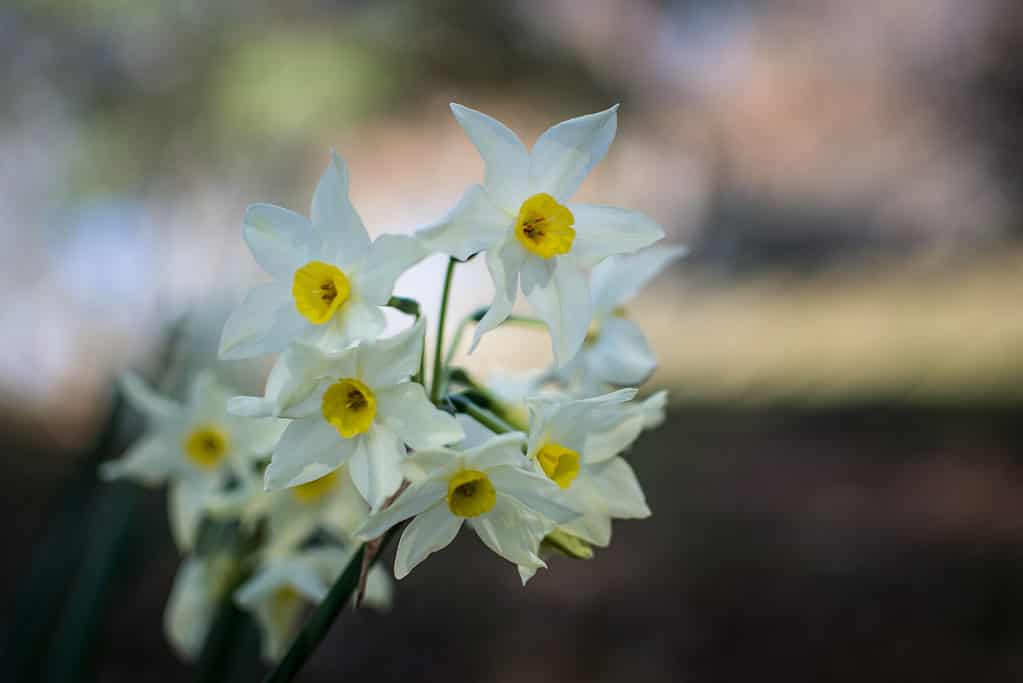
Jonquils are daffodils with multiple flowers per stem and other unique characteristics.
©iStock.com/Steven Giles
Jonquils vs. Daffodils
If you need clarification about which flowers are jonquils and which ones are daffodils, you’re not alone! So let’s make it clear. The name jonquil is short for jonquilla, and jonquillas are a specific type of daffodil. That means all jonquils are daffodils, but not all daffodils are jonquils.
Now, let’s discover how to recognize a jonquil when you see one. The easiest way to do that is to learn about the jonquilla division of daffodils. Jonquilla daffodils belong to Division #7 of the 13 official daffodil divisions.
Daffodils in the jonquilla division have the following characteristics:
- Jonquils have up to eight flowers per stem, though typically only 1-5
- Their petals (perianth segments) are either reflexed or spreading
- Jonquil cups (coronas) are either flared, shaped like cups, or shaped like funnels
- Their blooms typically grow wider than they are long
- Jonquils have a strong and pleasing scent
And one more thing we should make clear about jonquils and daffodils. Both of them belong to the genus called Narcissus. We hope the following breakdown makes this fact easy to remember:
- All jonquils are daffodils
- All daffodils are Narcissus plants
If you’re curious about the other 12 daffodil divisions, take a peek at our list below.
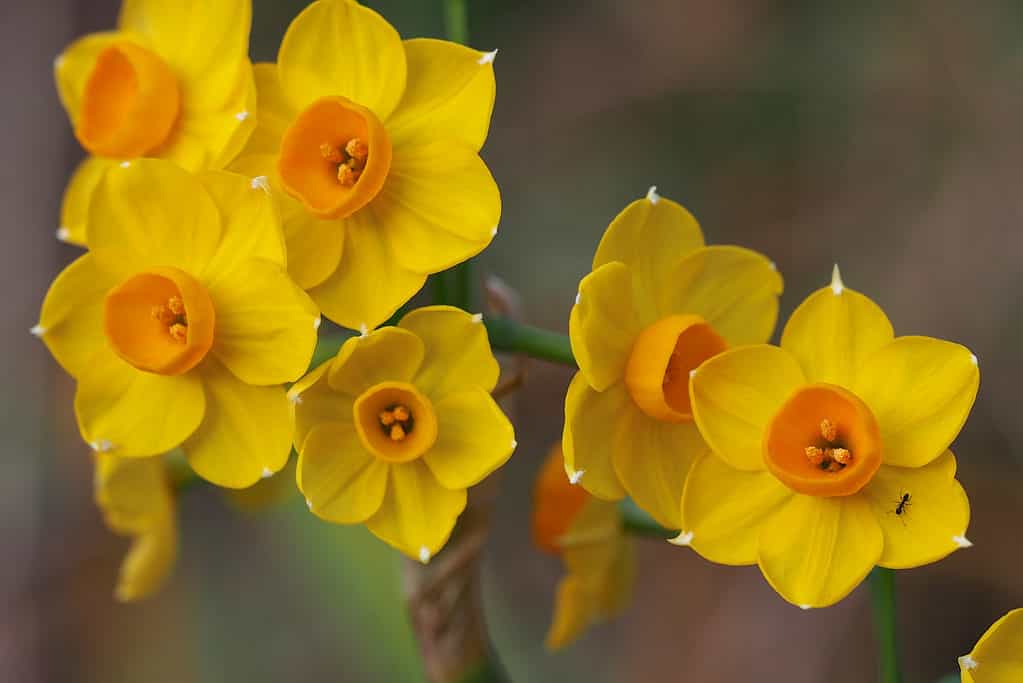
Jonquils are also called Jonquillas and belong to their own division of daffodils.
©iStock.com/ralphgillen
Daffodil Classification
As we just learned above, jonquilla or jonquil daffodils have their own classification division. But do you know what the rest of the 13 daffodil divisions are? If not, check out our handy list below of each division title.
- Trumpet Daffodils = Division #1
- Large-Cupped Daffodils = Division #2
- Small-Cupped Daffodils = Division #3
- Double Daffodils = Division #4
- Triandrus Daffodils = Division #5
- Cyclamineus Daffodils = Division #6
- Jonquilla Daffodils = Division #7
- Tazetta Daffodils = Division #8
- Poeticus Daffodils = Division #9
- Bulbocodium Daffodils = Division #10
- Split-Cupped Collar Daffodils = Division #11a
- Split-Cupped Papillion Daffodils = Division #11b
- Other Daffodil Cultivars = Division #12
- Daffodils Categorized Only by Botanical Name = Division #13
All of the featured flowers in this article are jonquils and belong to Division #7. So, let’s take a look at the 10 types of jonquil daffodils you won’t want to miss!
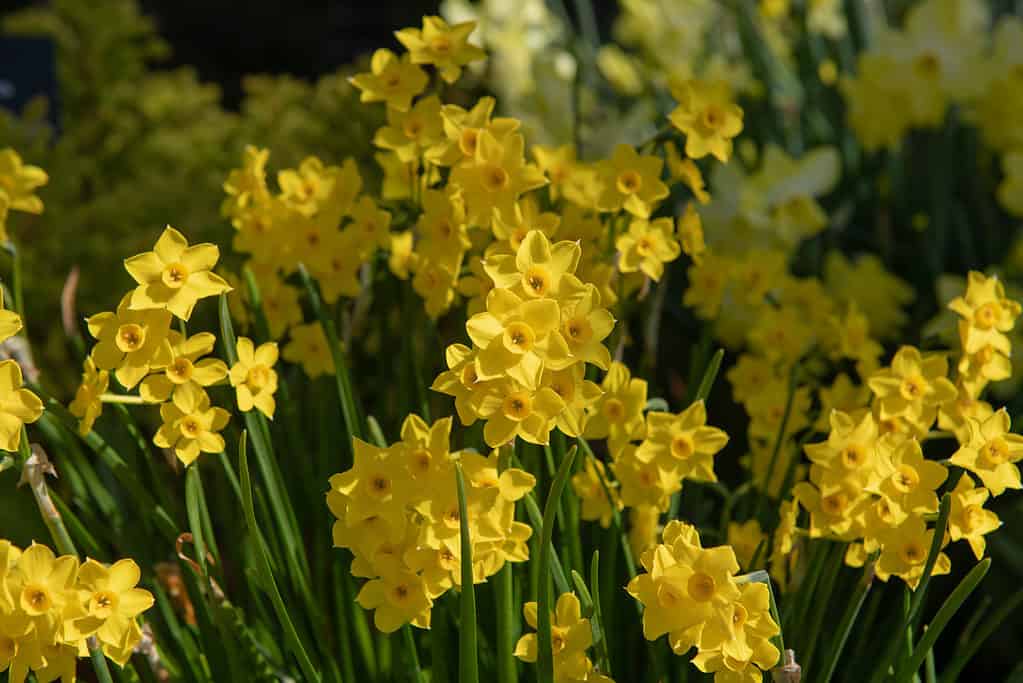
Yellow ‘Baby Boomer’ jonquil daffodils produce many fragrant blooms.
©Peter Turner Photography/Shutterstock.com
1. Narcissus ‘Baby Boomer’
Botanical Name: Narcissus ‘Baby Boomer’
Common Names: ‘Baby Boomer’ Jonquil, ‘Baby Boomer’ Daffodil, Miniature Daffodil ‘Baby Boomer’
Hardiness Zones: 4-9
Bloom Seasons: Spring (Mid)
Type of Daffodil: Jonquilla, Division #7
Fragrance: Strong and sweet scent
Flower Colors: Bright yellow petals with golden yellow cups
The ‘Baby Boomer’ jonquil is an all-yellow miniature daffodil that produces around 1-5 flowers per stem. Perhaps the high number of baby blooms is where the ‘Baby Boomer’ name comes from! Not only is this petite jonquil daffodil full of colorful yellow petals, but it’s also a sweet-smelling plant.
‘Baby Boomer’ daffodils grow 9-12 inches tall and produce 1-2 inch blooms.
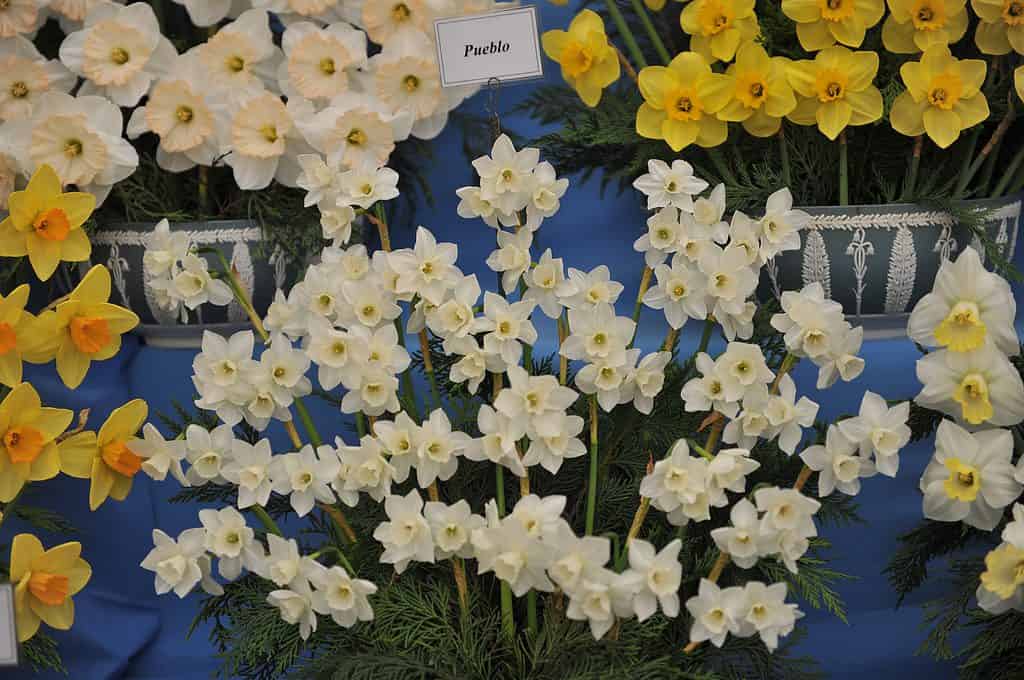
White and dainty ‘Pueblo’ jonquils bloom in mid-spring.
©Sergey V Kalyakin/Shutterstock.com
2. Narcissus ‘Pueblo’
Botanical Name: Narcissus ‘Pueblo’
Common Names: ‘Pueblo’ Jonquil, ‘Pueblo’ Daffodil
Hardiness Zones: 5-9
Bloom Seasons: Spring (Mid)
Type of Daffodil: Jonquilla, Division #7
Fragrance: Strong, pleasing scent
Flower Colors: White petals with a yellow cup that fades to white
‘Pueblo’ jonquils are sweet-smelling white daffodils that usually produce 1-3 wide blooms per stem. Their 3-inch flowers consist of milky-white petals and light yellow cups. However, as this plant’s blooms mature, its yellow cups also turn white. For those appealing features and more, the ‘Pueblo’ is a popular type of jonquil daffodil for home gardens.
The ‘Pueblo’ jonquilla daffodil grows about 14 inches tall and blooms mid-spring.

‘Silver Smiles’ is a type of jonquil daffodil with a yellow cup that matures to white.
©Nikolay Kurzenko/Shutterstock.com
3. Narcissus ‘Silver Smiles’
Botanical Name: Narcissus ‘Silver Smiles’
Common Names: ‘Silver Smiles’ Jonquil, ‘Silver Smiles’ Daffodil
Hardiness Zones: 4-9
Bloom Seasons: Spring (Mid to Late)
Type of Daffodil: Jonquilla, Division #7
Fragrance: Strong, pleasing scent
Flower Colors: White petals with a yellow cup that matures to white
The ‘Silver Smiles’ jonquil is a later-blooming daffodil that brings a subtle drift of color to spring gardens. It produces about three flowers per stem, each with white petals and soft yellow cups that eventually change to white. In addition, the ‘Silver Smiles’ jonquil daffodil also has a lovely fragrance that adds to its beauty and charm.
This jonquilla daffodil grows 1-2 feet tall and performs well in the higher heat of late spring.
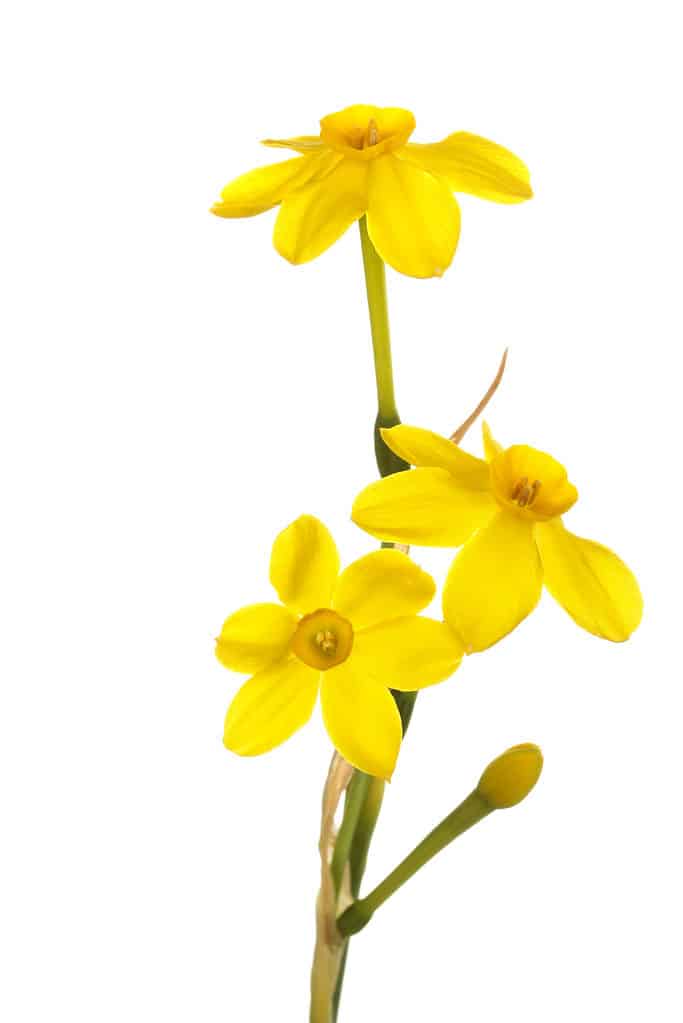
‘Baby Moon’ is a late-blooming type of jonquil daffodil.
©iStock.com/sgoodwin4813
4. Narcissus ‘Baby Moon’
Botanical Name: Narcissus ‘Baby Moon’
Common Names: ‘Baby Moon’ Jonquil, ‘Baby Moon’ Daffodil
Hardiness Zones: 4-9
Bloom Seasons: Spring (Late)
Type of Daffodil: Jonquilla, Division #7
Fragrance: Very fragrant
Flower Colors: Bright yellow petals and cups
The ‘Baby Moon’ miniature jonquil has pretty little flowers that stay all-yellow all season, from petals to cups. You can expect 3-5 flowers per stem on this type of jonquil daffodil. Plus, the ‘Baby Moon’ keeps a sweet aroma wafting through the garden after the early-spring daffodils have lost their blooms.
This miniature daffodil grows only 8-12 inches tall but makes for an impressive sight when planted in big groupings.

‘Sailboat’ jonquils typically produce 2-3 flowers per stem.
©Alex Manders/Shutterstock.com
5. Narcissus ‘Sailboat’
Botanical Name: Narcissus ‘Sailboat’
Common Names: ‘Sailboat’ Jonquil, ‘Sailboat’ Daffodil
Hardiness Zones: 3-9
Bloom Seasons: Spring (Mid)
Type of Daffodil: Jonquilla, Division #7
Fragrance: Sweet and robust scent
Flower Colors: White petals with a light yellow cup
The’ Sailboat’ jonquil is an excellent choice for mid-spring blooms in your garden. With its pearly-white petals and light yellow cups, ‘Sailboat’ usually produces three beautiful 2-3 inch flowers per stem. And, like other types of jonquil daffodils, these flowers have a delightful fragrance.
This jonquilla daffodil grows about 1 foot tall. In addition, it’s a winner of the Royal Horticultural Society’s Award of Garden Merit.
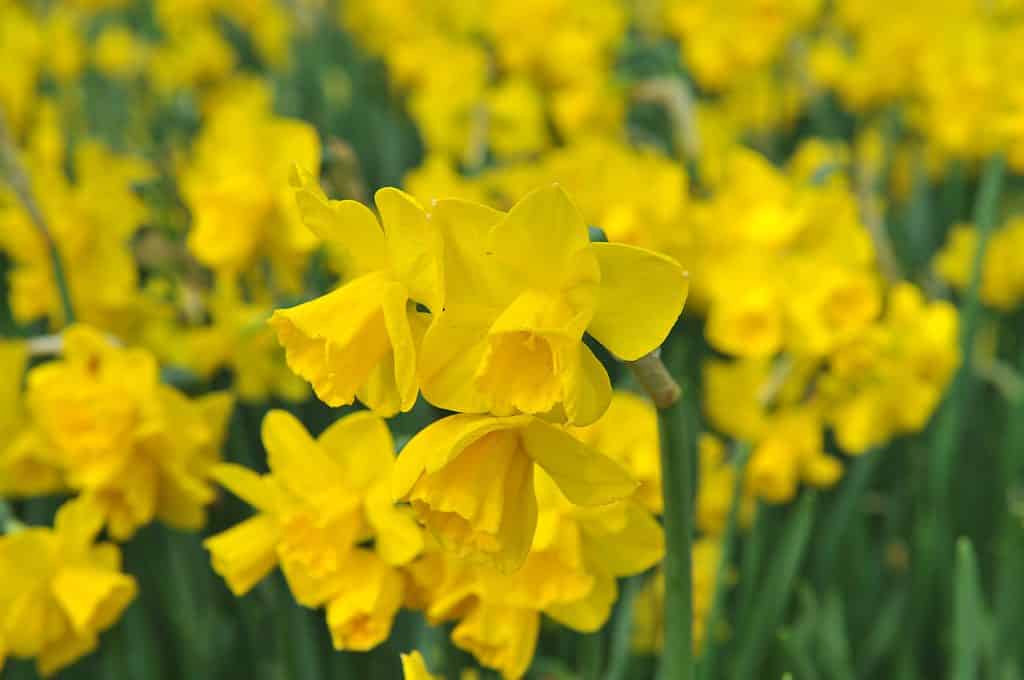
Yellow ‘Quail’ jonquils are award-winning daffodils.
©Sergey V Kalyakin/Shutterstock.com
6. Narcissus ‘Quail’
Botanical Name: Narcissus ‘Quail’
Common Names: ‘Quail’ Jonquil, ‘Quail’ Daffodil
Hardiness Zones: 3-9
Bloom Seasons: Spring (Mid)
Type of Daffodil: Jonquilla, Division #7
Fragrance: Very fragrant
Flower Colors: Golden yellow petals and cups
Another award-winning jonquil on our list, the ‘Quail’ jonquil blooms in mid-spring with beautiful golden-yellow petals and cups. This all-yellow jonquil has a strong, pleasant fragrance and produces about 2-4 flowers per stem.
This type of jonquil daffodil grows about 1-2 feet tall and produces long-lasting 2-3 inch flowers. It’s also another award-winning jonquil as a recipient of the Royal Horticultural Society’s respected Award of Garden Merit.
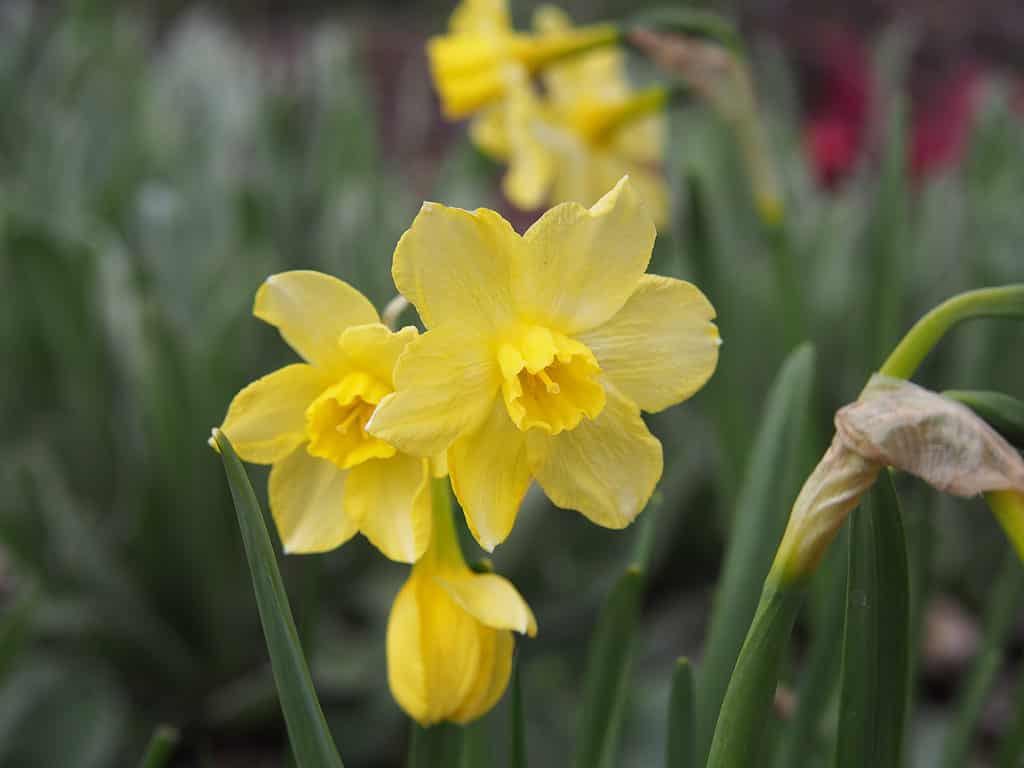
‘Pipit’ daffodil cups eventually fade from yellow to white.
©Anna Gratys/Shutterstock.com
7. Narcissus ‘Pipit”
Botanical Name: Narcissus ‘Pipit’
Common Names: ‘Pipit’ Jonquil, ‘Pipit’ Daffodil
Hardiness Zones: 3-9
Bloom Seasons: Spring (Mid)
Type of Daffodil: Jonquilla, Division #7
Fragrance: Lovely, sweet scent
Flower Colors: Lemon-yellow flowers with cups that mature to white
The ‘Pipit’ jonquil is a beauty with its bright lemony petals and cups. But note that pretty ‘Pipit’ is another color-changing daffodil with cups that mature from yellow to white. This jonquil daffodil usually produces 2-3 flowers per stem that extend up to 3 inches wide. In addition, the ‘Pipit’ jonquil is known for its sweet fragrance that adds even more appeal to spending time admiring its blooms.
This jonquilla daffodil grows 8-12 inches tall and provides bright lemon color to the garden in mid-spring. ‘Pipit’ flowers are long-lasting (up to five weeks of bloom time). And these jonquils earned the Award of Garden Merit from the UK’s Royal Horticultural Society.

Jonquils like ‘Golden Echo’ daffodils make a big impact in the garden when planted in groupings.
©Gabriela Beres/Shutterstock.com
8. Narcissus ‘Golden Echo’
Botanical Name: Narcissus ‘Golden Echo’
Common Names: ‘Golden Echo’ Jonquil, ‘Golden Echo’ Daffodil
Hardiness Zones: 3-9
Bloom Seasons: Spring (Early to Mid)
Type of Daffodil: Jonquilla, Division #7
Fragrance: Sweet-smelling scent
Flower Colors: Petals that are white at the top and yellow at the base, with bright yellow cups
The ‘Golden Echo’ jonquil is a striking daffodil that brings lovely yellow-and-white color to garden beds early to mid-spring. Its flower cups are bright yellow, and its petals are primarily white, with yellow reflected (under the cup) through the base. In addition, this type of jonquil daffodil provides an enchanting fragrance and multiple dainty flowers per stem.
‘Golden Echo’ grows 12-16 inches tall and has long prominent cups. Plus, these beautiful jonquil daffodils have flowers that last quite a long time. All the better for continuous color and scent in your spring garden beds!

‘Sun Disc’ jonquil daffodils are yellow flowers with disc-shaped cups.
©Peter Turner Photography/Shutterstock.com
9. Narcissus ‘Sun Disc’
Botanical Name: Narcissus ‘Sun Disc’
Common Names: ‘Sun Disc’ Jonquil, ‘Sun Disc’ Daffodil
Hardiness Zones: 3-8
Bloom Seasons: Spring (Mid to Late)
Type of Daffodil: Jonquilla, Division #7
Fragrance: Sweetly scented
Flower Colors: Pale yellow petals with golden yellow cups
The ‘Sun Disc’ jonquil daffodil blooms later in the spring with light yellow flowers that have golden yellow cups. This type of jonquil daffodil has flatter cups that resemble discs, which inspired its name. And though ‘Sun Disc’ jonquils can grow up to 10-12 inches tall, they are often shorter and categorized as miniature daffodils.
The late-blooming ‘Sun Disc’ daffodil earned the Award of Garden Merit from the esteemed Royal Horticultural Society.
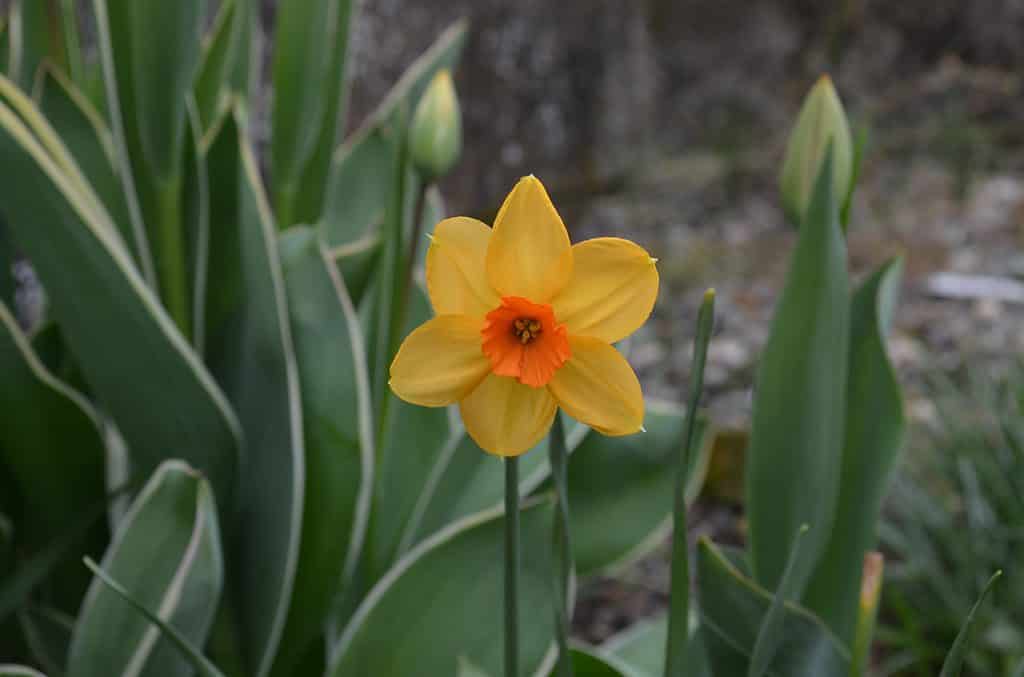
‘Kedron’ jonquilla daffodils have golden yellow petals and red-orange cups.
©Aleksandr Naumenko/Shutterstock.com
10. Narcissus ‘Kedron’
Botanical Name: Narcissus ‘Kedron’
Common Names: ‘Kedron’ Jonquil, ‘Kedron’ Daffodil
Hardiness Zones: 3-8
Bloom Seasons: Spring (Mid to Late)
Type of Daffodil: Jonquilla, Division #7
Fragrance: Strongly-sweet scent
Flower Colors: Golden petals with red-orange cups
The ‘Kedron’ jonquil is a vibrant bicolor daffodil that produces about two flowers per stem. The blooms of this gorgeous plant pop in mid-to-late spring with golden petals and red-orange disc-shaped cups. Also, some of the reddish colors from its cups reflect down through the base of its petals for an even showier bloom.
‘Kendron’ jonquil plants grow 12-14 inches tall with 2-3 inch flowers that fill the landscape with a sweet scent of spring.
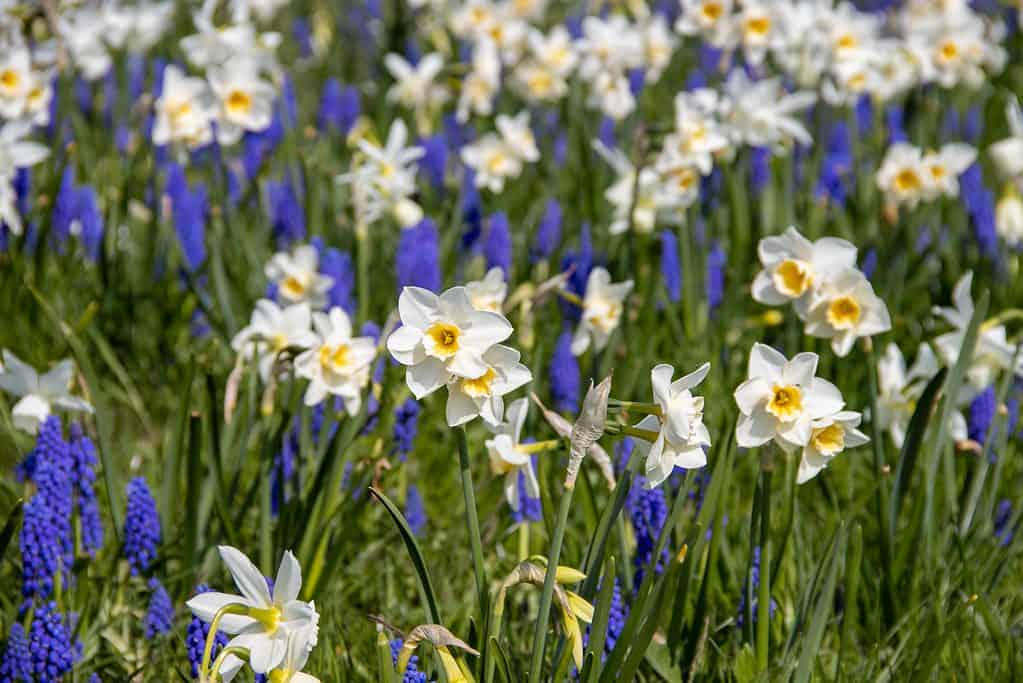
Daffodils come back healthier next year if you wait to prune the plants until the leaves turn yellow or brown.
©Foxxy63/Shutterstock.com
Best Practices for Growing Jonquils
Like other types of daffodils, jonquils are easy to grow and should come back every spring for many years. However, giving your jonquilla daffodils the best care possible will ensure they stay healthy and perform well year after year. So, if you’re a beginner with jonquil gardening, consider using these best practice tips for bulb planting and care.
- Jonquil bulbs should be planted in autumn, preferably before the first frost. This timing is because daffodil bulbs need anywhere from 8-15 weeks of dormancy in temps below 40 degrees Fahrenheit to grow properly in the spring.
- Choose jonquil bulbs that are firm to the touch.
- When placing bulbs in the soil, the pointy side of the bulb should be at the top and the roots resting at the bottom.
- A common rule of thumb for garden beds is to plant jonquil bulbs about 6 inches deep and 3-4 inches apart in the soil. However, bulbs vary in size, so a better practice is to plant bulbs as deep as three times their size. For example, based on this practice, a 2-inch bulb is placed 6 inches deep in the soil.
- When planting in containers, make sure jonquil pots are at least 12 inches deep for healthy root growth. Also, jonquil containers need great drainage, with bulbs placed close together but not touching other bulbs. And a mix of potting soil plus compost makes potted jonquils very happy.
- Water your jonquil plants right after planting. Then water them about once a week in the spring once the plants appear. Water potted jonquils when the top inch of soil feels dry to the touch.
- Once your jonquil blooms wilt, wait to cut back the plants until their leaves are yellow or brown. Daffodils need to soak up as much energy as possible under the sun before going dormant again. This practice of delayed pruning will help your bulbs perform well again next spring.
All Jonquils are Daffodils with Unique Characteristics
If you didn’t know it already, we hope it’s easy to understand that all jonquils are daffodils. But jonquils or jonquillas have their own division and characteristics that make them special. For example, they have multiple blooms per stem, spreading or reflexed petals, cups with specific shapes, and a lovely scent.
Any of the 10 types of jonquil daffodils in this article would bring spring dazzle to gardens and containers. And with their differing bloom seasons, sizes, and scents, you could create an entire season of unique garden colors and fragrances. Follow the best practices for growing jonquils, and your spring flowers will bloom year after year.
The photo featured at the top of this post is © Jackie Tweddle/Shutterstock.com
Thank you for reading! Have some feedback for us? Contact the AZ Animals editorial team.






